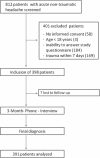Copeptin for risk stratification in non-traumatic headache in the emergency setting: a prospective multicenter observational cohort study
- PMID: 28197843
- PMCID: PMC5307398
- DOI: 10.1186/s10194-017-0733-2
Copeptin for risk stratification in non-traumatic headache in the emergency setting: a prospective multicenter observational cohort study
Abstract
Background: In the emergency setting, non-traumatic headache is a benign symptom in 80% of cases, but serious underlying conditions need to be ruled out. Copeptin improves risk stratification in several acute diseases. Herein, we investigated the value of copeptin to discriminate between serious secondary headache and benign headache forms in the emergency setting.
Methods: Patients presenting with acute non-traumatic headache were prospectively enrolled into an observational cohort study. Copeptin was measured upon presentation to the emergency department. Primary endpoint was serious secondary headache defined by a neurologic cause requiring immediate treatment of the underlying disease. Secondary endpoint was the combination of mortality and hospitalization within 3 months. Two board-certified neurologist blinded to copeptin levels verified the endpoints after a structured 3-month-telephone interview.
Results: Of the 391 patients included, 75 (19%) had a serious secondary headache. Copeptin was associated with serious secondary headache (OR 2.03, 95%CI 1.52-2.70, p < 0.0001). Area under the curve (AUC) for copeptin to identify the primary endpoint was 0.70 (0.63-0.76). After adjusting for age > 50, focal-neurological abnormalities, and thunderclap onset of symptoms, copeptin remained an independent predictive factor for serious secondary headache (OR 1.74, 95%CI 1.26-2.39, p = 0.001). Moreover, copeptin improved the AUC of the multivariate logistic clinical model (p-LR-test < 0.001). Even though copeptin values were higher in patients reaching the secondary endpoint, this association was not significant in multivariate logistic regression.
Conclusions: Copeptin was independently associated with serious secondary headache as compared to benign headaches forms. Copeptin may be a promising novel blood biomarker that should be further validated to rule out serious secondary headache in the emergency department.
Trial registration: Study Registration on 08/02/2010 as NCT01174901 at clinicaltrials.gov.
Keywords: Biomarker; Copeptin; Emergency; Head pain; Headache; Vasopressin.
Figures
Similar articles
-
Stress markers predict mortality in patients with nonspecific complaints presenting to the emergency department and may be a useful risk stratification tool to support disposition planning.Acad Emerg Med. 2013 Jul;20(7):670-9. doi: 10.1111/acem.12172. Acad Emerg Med. 2013. PMID: 23859580
-
Combination of copeptin and troponin assays to rapidly rule out non-ST elevation myocardial infarction in the emergency department.Acad Emerg Med. 2012 May;19(5):517-24. doi: 10.1111/j.1553-2712.2012.01350.x. Acad Emerg Med. 2012. PMID: 22594355 Clinical Trial.
-
The utility of copeptin in the emergency department as a predictor of adverse outcomes in non-ST-elevation acute coronary syndrome: the COPED-PAO study.Emerg Med J. 2014 Apr;31(4):286-91. doi: 10.1136/emermed-2012-201996. Epub 2013 Jan 31. Emerg Med J. 2014. PMID: 23371977
-
The role of copeptin as a diagnostic and prognostic biomarker for risk stratification in the emergency department.BMC Med. 2012 Jan 20;10:7. doi: 10.1186/1741-7015-10-7. BMC Med. 2012. PMID: 22264220 Free PMC article. Review.
-
Prognostic value of copeptin in patients with acute stroke.Expert Rev Neurother. 2015 May;15(5):563-70. doi: 10.1586/14737175.2015.1030734. Epub 2015 Apr 12. Expert Rev Neurother. 2015. PMID: 25865618
Cited by
-
Relevance of cortisol and copeptin blood concentration changes in an experimental pain model.Sci Rep. 2022 Mar 19;12(1):4767. doi: 10.1038/s41598-022-08657-4. Sci Rep. 2022. PMID: 35306524 Free PMC article.
-
Early detection of stroke at the sudden sensorineural hearing loss stage.Front Neurol. 2023 Nov 1;14:1293102. doi: 10.3389/fneur.2023.1293102. eCollection 2023. Front Neurol. 2023. PMID: 38020605 Free PMC article.
-
Nontraumatic Headache in Adult Emergency Patients: Prevalence, Etiologies, and Radiological Findings.J Clin Med. 2020 Aug 12;9(8):2621. doi: 10.3390/jcm9082621. J Clin Med. 2020. PMID: 32806717 Free PMC article.
-
Activation of Vasopressin System During COVID-19 is Associated With Adverse Clinical Outcomes: An Observational Study.J Endocr Soc. 2021 Mar 17;5(6):bvab045. doi: 10.1210/jendso/bvab045. eCollection 2021 Jun 1. J Endocr Soc. 2021. PMID: 34056499 Free PMC article.
-
Novel Biomarkers to Detect Target Organ Damage in Acute Hypertension.Curr Hypertens Rep. 2018 Mar 19;20(3):21. doi: 10.1007/s11906-018-0818-6. Curr Hypertens Rep. 2018. PMID: 29556795 Review.
References
-
- Schuetz P, Christ-Crain M, Wolbers M, Schild U, Thomann R, Falconnier C, Widmer I, Neidert S, Blum CA, Schonenberger R, Henzen C, Bregenzer T, Hoess C, Krause M, Bucher HC, Zimmerli W, Muller B, Pro Hsg Procalcitonin guided antibiotic therapy and hospitalization in patients with lower respiratory tract infections: a prospective, multicenter, randomized controlled trial. BMC Health Serv Res. 2007;7:102. doi: 10.1186/1472-6963-7-102. - DOI - PMC - PubMed
-
- Ang SH, Chan YC, Mahadevan M. Emergency department headache admissions in an acute care hospital:why do they occur and what can we do about it? Ann Acad Med Singapore. 2009;38:1007–1010. - PubMed
Publication types
MeSH terms
Substances
Associated data
LinkOut - more resources
Full Text Sources
Other Literature Sources
Medical



